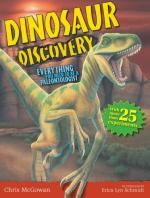|
This section contains 577 words (approx. 2 pages at 300 words per page) |

|
Paleontology is the study of the history of life as revealed in the fossil record. Fossils are remnants or traces of living organisms from past geologic ages that have become preserved in Earth's crust. They include not only the skeletons or shells of deceased creatures, but also burrows, footprints, eggs, and fossilized feces (excrement), known as coprolites.
Paleontology draws extensively from both biology and geology. Some subdisciplines of paleontology are defined by the types of organisms that are studied. Examples are vertebrate paleontology, invertebrate paleontology, paleobotany, and micropaleontology (study of single-celled fossils). Paleoecologists study extinct ecosystems. Related areas include biostratigraphy, the study of fossil distributions in different strata (rock layers), and taphonomy, which examines the process of fossil formation. Biological disciplines in which contributions of paleontology are particularly critical include systematics and taxonomy. They focus on determining phylogenetic relationships (the sequence of branching events in evolutionary history which...
|
This section contains 577 words (approx. 2 pages at 300 words per page) |

|


